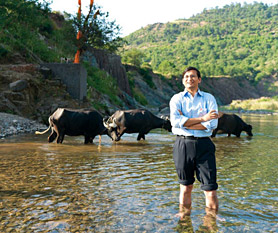Our Commitment to Conservation
Worldwide efforts to reduce water use and eliminate water waste show results.
Standing in a river at the foothills of the Himalayas in northern India, Achal Gupta recalls a simpler time that allowed for a different kind of closeness to nature’s vital resource.
“When water is flowing, there is a natural music that today is becoming rare to find,” he says. “We have to be careful to use water thoughtfully and to protect its supply for future generations.”
Around the world, water—one of the earth’s most critical resources—is under threat: Scarcity is increasing, demand is inequitable, access is lacking, and quality is declining. Even in India, where social and religious traditions have fostered a sincere reverence for water as a source of life, parts of the country are among the most water-scarce areas in the world.
Achal is Manager of Environment, Health and Safety (EHS) at the Johnson & Johnson Consumer manufacturing facility in Baddi, Himachal Pradesh. The water management efforts he oversees include a zero-discharge wastewater treatment facility—every drop of treated water is reused for irrigation and toilet flushing.
Rain harvesting began in 2008. Water is collected from the rooftop and recharged to the ground using a harvest pit. “The huge amount of water during monsoon season was going directly to the storm drain and was wasted,” says Achal. “So we decided to make use of it.”
These water management efforts contribute to enterprise-wide water reduction goals, which have been in place for about 15 years. The Company’s Healthy Planet 2010 goal for water use is a 10 percent absolute reduction against the 2005 baseline. Thanks to numerous efforts at the local level, Johnson & Johnson is on target to reach this goal by the end of 2010. New goals will go into effect in January 2011.
“The enterprise-level goals are very demanding,” says S. Radhakrishnan, Manager of Environment, Health and Safety, Johnson & Johnson Ltd. in Mulund, India. “We’re careful to review our local efforts to ensure compliance with enterprise standards as well as community needs.”
Efforts are made within regions to share best practices, as well as to understand the context and combined impact of local initiatives. Additional efforts under way include using treated wastewater to maintain lawns in front of a consumer manufacturing and research and development center in Mulund, in the northeastern part of Mumbai, and to nurture 1,400 trees planted on the property.
At an Ethicon facility in Aurangabad, in western India, a water storage tank was installed, along with piping modifications that reduced water pressure, cutting overall consumption. Even small steps, like installing auto-close taps on sinks, have helped. Meanwhile, training and lectures on water conservation are organized for employees.
“We have a responsibility to maintain our environment while performing our business efforts to meet our customers’ needs,” says Achal. “We’re developing ourselves in such a way that future generations will feel proud of us, our commitment and our actions.”


